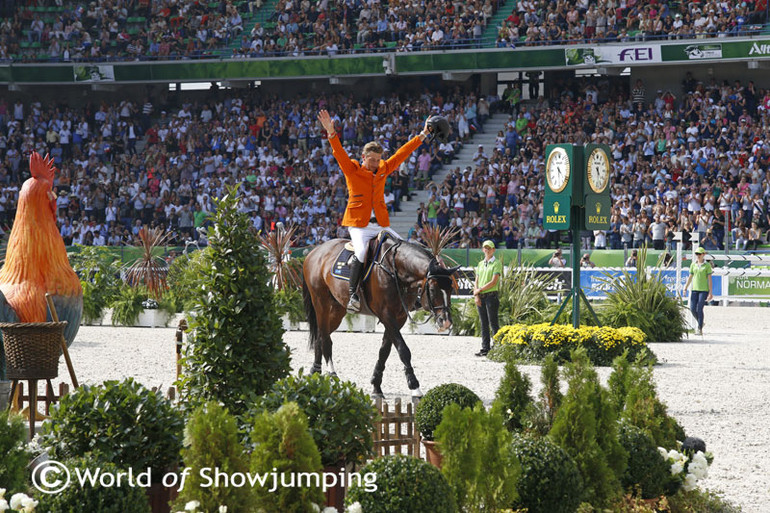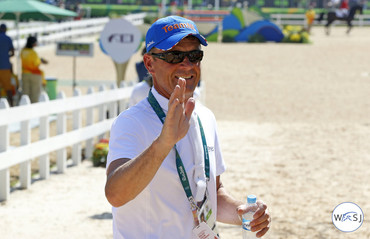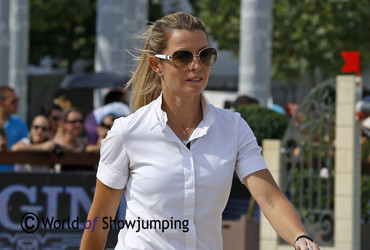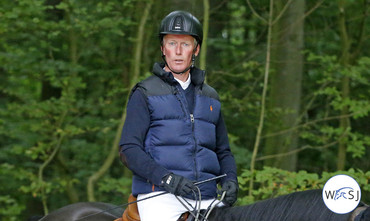In World of Showjumping’s new series ‘The Voice of the Riders’ we will invite some of the top names in jumping to give their views as important questions and decisions concerning our sport arise.
With the recent changes made on the jumping format for the World Championships – that included removing the top four final and horse rotation between the riders – World of Showjumping decided to let this be the first topic of our new series.
All of the riders we have spoken to are former participants in the final of four at the World Equestrian Games, and here you can read about their view on the changes.
Jeroen Dubbeldam (NED) – World Champion at the World Equestrian Games in Caen in 2014 with his horse SFN Zenith:
“Perhaps I am not the right person to ask, as the horse rotation in the top four final was what made me the World Champion. (Note from editor: Jeroen was sitting fourth ahead of the final of four in Caen).
Personally, I am a fan of this format. If I look towards my home country Netherlands, the top four final made people outside the sport enthusiastic about it and the interest in it grew afterwards. It gave us as rider more respect I think. It is difficult to create interest for jumping among the general public, but this is what the format of the final of four managed to do. Speaking on my own behalf, I regret that it has been removed.
I can understand the risks involved, but still even with Zenith – who was a bit nervous and inexperienced back then – the rotation did not make him suffer in any way. Four weeks later he was at the Nations Cup Final in Barcelona jumping clear to win it with the Dutch team, and the year after he was double European Champion. I believe that the top four final just made him grow as a horse, and he became even better from it.
Removing the opening round with a table C is also something I think is a little bit dangerous, and under the new rules the chances to get through from the first day of competition to the second is reduced considerably. I don’t know how this will affect the motivation of the riders, perhaps some will think that it is not worth it to try when the chances are so much smaller.
I also think that the speed competition should be a part of any championship. A good rider should be able to do a decent table C round, it is a part of our sport and a part of our championship-tradition. Perhaps removing it takes some of the pressure off the horses when it comes to the amount of jumping, but there were also other ways to reduce the rounds they have to jump.
My suggestion would have been to leave the speed class and the team competitions as it was under the former format, and rather remove one of the two rounds in the individual competition that used to be held on the Saturday to reduce the amount of jumping. Then I would have kept the top four final with the horse rotation, however changing it so that the riders would have brought their penalty scores from the previous rounds of competition with them into the final.”
Edwina Tops-Alexander (AUS) – competed in the final of four at the World Equestrian Games in Aachen in 2006 with her horse Pialotta:
“I think the concept with the final of four and a horse rotation was more appealing for the public than the riders.
At the World Championships in Aachen, I calculated averagely how many jumps my horse Pialotta ended up doing in total and it was over 300 jumps in seven days. This illustrates that a concept like this is not about the welfare of the horse. Looking back, I also think that quite a few of the horses in those finals struggled to make it back in the sport afterwards and some never did.
It was a big deal to win the final, but at the same time it was also a massive sacrifice involved for your horse. It was also a huge risk involved; I mean you never knew who would end up on your horse. I would feel horrible if something happened to my horse with one of the other three riders on it, or if I did something wrong with one of their horses. What if I ended up crashing one of the horses because I did not ride too good, or vice versa? That would also not be very good for our sport towards the public, and I think we have been lucky that there have been no such incidents.
The final of four was perhaps unbelievable to watch, but I don’t think it was a true championship under this format. Also one of the four riders in the final rode for nothing, ending up outside the podium – that never felt fair.
This is why I think the new format is a better way to crown a champion, and I am impressed to see that they changed it.”
Jos Lansink (BEL) – World Champion at the World Equestrian Games in Aachen in 2006 with his horse Cavalor Cumano:
“Personally, I found the top four final to be an unbelievable experience. To be able to go into the top four final at the World Championships staged in Aachen in front of 50.000 spectators – I remember it like it was yesterday and find it hard to describe the incredible feeling it gave me... To be able to sit on some of the best horses in the world in a competition like that, it is a once-in-a-lifetime experience. I have to say, the FEI took something very special away.
I know it’s a lot of jumping for the horses during that week of competition, but that is a part of it and how it should be – it is after all a World Championship. Everybody works towards this, and if you are a real horseperson you come there with a fresh horse that has been saved and build up for that occasion.
For me, I don’t see any negative sides to the horse rotation. You have the four best horses through the championship that end up in the final, and the four best riders – that means they all are in top form and should be more than capable to handle that format.
Also, I can not remember any bad pictures coming out from the horse swap. Rather the opposite; people love to watch it – even on TV, it shows top sport and is really easy to follow also for those not that into our sport. I still have people coming up to me that remember the final in Aachen to detail, even though it’s ten years ago. I mean usually, people tend to forget who won that and that Grand Prix a few weeks later – so I think it says something about the importance of the top four final. I would 100 % have liked to see it stay.
With the new format that has been voted through, we get the same as we see every single weekend – the individual competition will be just like a Grand Prix perhaps with a jump-off with the only difference being that faults are carried through from the team jumping. I don’t understand why the FEI wanted to change something so popular and nice into a format that is completely similar to what we see all the time every week.
I prefer the championships to have a bit their own personality. The World Championships had that, now it’s been taken away. No bad words about the Olympics, but in the end that is also similar to a Grand Prix over two rounds with a jump-off if needed – it’s just that it’s called the Olympic Games. Now, the World Championships will be the same, and I think that is a pity. They should have kept it as it was.
I would also have appreciated if this had been properly discussed with the riders before the rules were changed. The way it’s done at the moment, it feels like the FEI is just changing the rules however they want to and we as riders have to adjust without having a say in anything. The next thing we will wake up to is a rule that we have to ride without a saddle.”
Text © World of Showjumping // Pictures © Jenny Abrahamsson
No reproduction without permission












